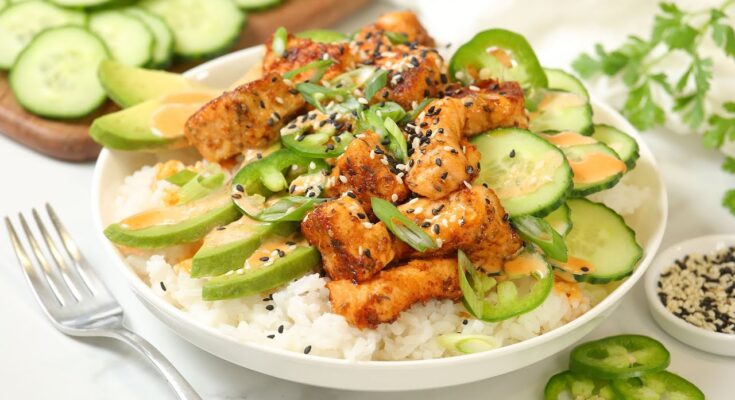Salmon Bowl Recipe: Salmon bowls are a delicious and nutritious meal option that’s easy to prepare and endlessly customizable. They combine tender, flaky salmon with a flavorful base, fresh vegetables, and a tasty sauce to create a dish that’s as appealing to the eyes as it is to the taste buds. Whether you’re looking for a quick weeknight dinner or a meal-prep-friendly recipe, salmon bowls have you covered.
Not only are these bowls versatile, but they also pack a nutritional punch. Salmon is rich in omega-3 fatty acids, which support heart and brain health, while the variety of toppings and bases provide fiber, vitamins, and minerals.
Ready to dive in? Let’s get started on crafting your perfect salmon bowl.
Ingredients Needed for a Perfect Salmon Bowl
Essential Ingredients for the Salmon
- 2 salmon fillets (about 6 oz each)
- Olive oil or avocado oil
- Soy sauce
- Honey or maple syrup
- Garlic and ginger (minced)
- Lemon or lime juice
- Salt and pepper
Ingredients for the Base
- 2 cups cooked rice (white, brown, or sushi rice)
- Alternative bases: quinoa, mixed greens, or soba noodles
Toppings and Garnishes
- Fresh vegetables: cucumbers, carrots, edamame, and avocado
- Garnishes: sesame seeds, green onions, and nori strips
- Optional extras: pickled ginger, radishes, or microgreens
Choosing the Right Salmon
Fresh vs. Frozen Salmon
Both fresh and frozen salmon can work well, but frozen salmon is often more affordable and equally nutritious. Make sure it’s vacuum-sealed to retain freshness.
How to Pick High-Quality Salmon
Look for salmon with vibrant, firm flesh. Avoid any that have a fishy odor or dull appearance.
Wild-Caught vs. Farm-Raised Salmon
Wild-caught salmon typically has a richer flavor and is leaner, while farm-raised salmon tends to be milder and higher in fat. Both are excellent options depending on your taste preference and budget.
Preparing the Salmon
The marinade is the secret to flavorful salmon bowls. Here’s a simple yet effective marinade recipe:
Ingredients for the Marinade:
- 2 tbsp soy sauce
- 1 tbsp honey or maple syrup
- 1 tsp sesame oil
- 1 clove garlic, minced
- 1 tsp grated ginger
- Juice of half a lemon
Marination Tips:
- Mix all ingredients in a bowl.
- Place the salmon fillets in a shallow dish and pour the marinade over them.
- Cover and refrigerate for 30 minutes (up to 2 hours for deeper flavor).
- Remove the salmon from the fridge about 10 minutes before cooking.
Cooking the Salmon
There are several ways to cook salmon, but here are the top three methods:
1. Grilling:
- Preheat the grill to medium-high heat.
- Brush the grates with oil to prevent sticking.
- Grill the salmon skin-side down for 4-5 minutes, then flip and cook for another 2-3 minutes.
2. Baking:
- Preheat the oven to 375°F (190°C).
- Place the salmon on a lined baking sheet and bake for 12-15 minutes until flaky.
3. Pan-Searing:
- Heat a non-stick skillet over medium heat with 1 tbsp olive oil.
- Cook the salmon skin-side up for 3-4 minutes, then flip and cook for another 2-3 minutes.
Pro Tip: Ensure the internal temperature of the salmon reaches 145°F (63°C) for safe consumption.
Preparing the Base for Your Salmon Bowl
The base sets the tone for your salmon bowl. Here are some options:
Rice:
Cook 1 cup of rice with 2 cups of water for perfect, fluffy grains. Season with a splash of rice vinegar and a pinch of salt for sushi-style rice.
Alternative Bases:
- Quinoa: High in protein and naturally gluten-free. Cook it in chicken or vegetable broth for added flavor.
- Mixed Greens: A lighter, low-carb option that pairs well with tangy sauces.
- Soba Noodles: For a hearty, Asian-inspired twist.
Flavor Enhancers:
Mix in chopped herbs, a drizzle of sesame oil, or a sprinkle of furikake seasoning for added flavor.
Adding Vegetables to the Salmon Bowl
A salmon bowl isn’t complete without a vibrant assortment of vegetables. Not only do they add a pop of color, but they also provide a refreshing crunch and balance the dish’s flavors. Here’s how to prepare them:
Choosing Fresh, Vibrant Vegetables
- Crunchy options: Carrots, cucumbers, radishes, and bell peppers.
- Creamy options: Sliced avocado or steamed sweet potatoes.
- Protein-packed choices: Steamed edamame or chickpeas.
Preparation Methods:
- Raw: Thinly slice cucumbers, carrots, or radishes for a crisp texture. Use a mandoline for even cuts.
- Steamed or Blanched: Steam broccoli florets or edamame for 3-5 minutes to retain their bright color.
- Roasted: Toss vegetables like sweet potatoes or zucchini with olive oil, salt, and pepper, then roast at 400°F (200°C) for 20 minutes until caramelized.
Pairing Vegetables with Salmon
Match the flavor profiles. For instance, roasted sweet potatoes pair well with teriyaki salmon, while raw cucumber and avocado complement spicy mayo or sesame ginger flavors.
Creating the Perfect Sauce
A great sauce can make or break your salmon bowl. Here are three popular options with recipes:
1. Spicy Mayo:
- 2 tbsp mayonnaise
- 1 tsp sriracha (adjust to taste)
- 1 tsp lemon juice
2. Sesame Ginger Sauce:
- 2 tbsp soy sauce
- 1 tbsp sesame oil
- 1 tbsp rice vinegar
- 1 tsp grated ginger
- 1 tsp honey
3. Teriyaki Glaze:
- 1/4 cup soy sauce
- 2 tbsp brown sugar
- 1 tsp cornstarch mixed with 1 tbsp water (for thickening)
Tips for Balancing Flavors:
- Taste as you go to achieve a balance of salty, sweet, tangy, and spicy elements.
- If the sauce is too salty, add a dash of honey or lemon juice.
Assembling Your Salmon Bowl
Now comes the fun part—assembling your bowl! Presentation matters, so aim for a balance of colors and textures.
Step-by-Step Guide:
- Start with the Base: Spread an even layer of rice, quinoa, or greens at the bottom of the bowl.
- Add the Vegetables: Arrange your chosen vegetables in sections around the bowl for a vibrant presentation.
- Place the Salmon: Lay the cooked salmon fillet on top, flaking it into chunks if desired.
- Drizzle the Sauce: Use a spoon or squeeze bottle to drizzle the sauce over the bowl.
- Garnish: Finish with sesame seeds, green onions, nori strips, or a squeeze of fresh lime.
Pro Tip: Use contrasting textures—like crunchy cucumbers with creamy avocado or tender salmon with crispy roasted vegetables—for a truly satisfying bite.
Customizing Your Salmon Bowl
The beauty of salmon bowls lies in their versatility. You can easily tailor the recipe to fit dietary preferences or restrictions.
Vegan and Vegetarian Variations:
- Replace salmon with marinated tofu, roasted chickpeas, or grilled eggplant.
- Opt for a tahini or peanut sauce instead of fish-based sauces.
Substitutes for Common Allergens:
- Use tamari instead of soy sauce for a gluten-free option.
- Swap out sesame oil and seeds for avocado oil if you’re avoiding sesame.
Kid-Friendly Adaptations:
- Keep the flavors mild by reducing spice levels in the marinade or sauce.
- Add kid-friendly toppings like shredded cheese or sliced cherry tomatoes.
Tips for Meal Prepping with Salmon Bowls
Salmon bowls are excellent for meal prepping because they can be made in advance and assembled quickly.
How to Store Salmon Bowls:
- Keep each component (salmon, rice, vegetables, and sauce) in separate airtight containers.
- Refrigerate for up to 3 days.
Reheating Tips:
- Warm the salmon and rice in the microwave for 1-2 minutes, then add fresh toppings and sauce before serving.
- Avoid reheating vegetables like avocado or cucumber; add them fresh.
Quick Assembly During Busy Weeks:
Pre-cut your vegetables and cook a larger batch of salmon and rice. Assemble the bowls in meal prep containers for grab-and-go lunches.
Serving Suggestions and Pairings
To elevate your salmon bowl, consider pairing it with complementary side dishes and beverages:
Side Dishes:
- A light miso soup or a refreshing seaweed salad.
- Spring rolls with a tangy dipping sauce.
Beverage Pairings:
- Green tea or iced matcha for a light, earthy note.
- White wine or sparkling water infused with citrus for a refreshing touch.
Troubleshooting Common Issues
No dish is without its challenges. Here’s how to solve common problems when making salmon bowls:
Overcooked or Dry Salmon:
- Add an extra drizzle of sauce to moisten the fish.
- Reduce the cooking time next time by 1-2 minutes.
Overly Salty Sauce:
- Balance it with a touch of honey or a squeeze of lemon.
Mushy Rice or Soggy Vegetables:
- Use less water when cooking rice, and avoid oversteaming vegetables.
Why Salmon Bowls Are a Sustainable Choice
Salmon bowls are not only delicious but also a sustainable meal option when prepared thoughtfully.
Environmental Benefits of Eating Salmon: Salmon has a lower carbon footprint compared to red meat. Choose wild-caught or sustainably farmed salmon to minimize environmental impact.
How to Choose Sustainable Seafood: Look for certifications like MSC (Marine Stewardship Council) or ASC (Aquaculture Stewardship Council).
Reducing Food Waste:
- Use vegetable scraps to make broth or stock.
- Save leftover rice for fried rice or soups.
FAQs about Salmon Bowl Recipe
What ingredients are needed for a salmon bowl?
A typical salmon bowl includes cooked salmon, rice or quinoa as a base, and a variety of toppings like avocado, cucumbers, edamame, and a drizzle of a savory sauce like soy or teriyaki.
How do I cook the salmon for a salmon bowl?
To cook salmon for a bowl, you can grill, bake, or pan-sear the salmon. Season it with salt, pepper, and your choice of spices. Cook until the salmon is opaque and flakes easily with a fork.
Is a salmon bowl healthy?
Yes, salmon bowls are generally healthy. Salmon is rich in omega-3 fatty acids, and when combined with a variety of vegetables and a whole grain base, it makes for a balanced meal packed with nutrients.
Can I meal prep salmon bowls for the week?
Absolutely! Cook the salmon and prepare your toppings and base ahead of time. Store them in separate containers in the refrigerator and assemble your bowls when ready to eat to maintain freshness.
What are some variations of the salmon bowl?
You can customize your salmon bowl with different sauces such as spicy mayo, wasabi, or ginger dressing. Also, feel free to swap out rice for other grains like farro or barley, or add different veggies or toppings like seaweed, sesame seeds, or scallions to suit your taste.
Conclusion
Creating a salmon bowl is more than just cooking; it’s crafting a balanced, nutritious, and visually stunning meal. From selecting fresh ingredients to customizing toppings, this guide gives you the tools to make a salmon bowl that’s uniquely yours. Whether you’re meal prepping or hosting a dinner, this dish is sure to impress.



